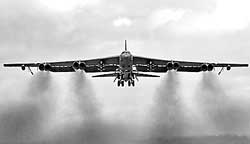
US Air Force describes errors in nuclear missile flightWASHINGTON, Saturday (AFP) - The Pentagon acknowledged yesterday of an unprecedented breakdown in procedures that allowed six nuclear missiles to mistakenly end up on a cross-country flight, an incident which took 36 hours to be discovered. “Nothing like this has ever occurred,” said Major General Richard Newton. “This was a failure to follow procedures, procedures that have proven to be sound.”He said at least four officers have been relieved of command, including the commander of the 5th Bomb Wing at Minot Air Force Base in North Dakota and two other colonels, in the wake of the August 30 incident.
Six nuclear armed cruise missiles on a pylon were loaded onto the wing of a B-52 bomber that was supposed to ferry other cruise missiles from Minot Air Force Base to Barksdale Air Force Base in Louisiana for decommissioning. The nuclear weapons were discovered nearly 36 hours later when they were unloaded at Barksdale, according to a timeline provided by Newton. An intensive six-week investigation concluded that the unauthorized transfer resulted from “a series of procedural breakdowns and human errors,”Newton said. He said there also was “an erosion in adherence to weapons handling standards” at both air force bases that had resulted in a lack of attention to detail. “It was a lack of effective supervision, a lack of effective leadership, and the fact that they were not following, nor did they adhere to these very strict checklist guideline procedures,” Newton said. At the root of the chain of errors was the failure of weapons maintenance crews to remove the nuclear warheads from the cruise missiles in preparation for transfer to Barksdale, he said. “The day-to-day mission out in the weapons storage area under the munitions control was lackadaisical. It, again, lacked the attention to detail. It lacked a formal process to the point where it became an informal process,” Newton said. Airmen assigned at Minot's weapons storage area failed to examine all the pylons located in the storage area on August 29, Newton said. Compounding that error, a crew moving pylons of cruise missiles to the aircraft by trailer began hooking up while the required inspection was under way, and then failed to verify that it had the right payload.“The crew is required to inspect the munitions before departing. They did not do that,” Newton said. Minot's mission control center should have caught the error by checking the pylon against a database when it was being loaded on the bomber at 9:25 am on August 29. But it failed to do so, Newton said.“At this point the wrong weapons already were in transit to the flight line and several safety procedures had been disregarded,” he said.“The Minot weapons handlers then loaded the munitions onto a B-52 and they remained there on a secure flight line,” he said. |
|| Front
Page | News | Editorial | Columns | Sports | Plus | Financial
Times | International | Mirror | TV
Times | Funday
Times || |
| |
Reproduction of articles permitted when used without any alterations to contents and the source. |
© Copyright
2007 | Wijeya
Newspapers Ltd.Colombo. Sri Lanka. All Rights Reserved. |
